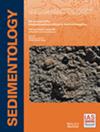Processes controlling Rare Earth Element distribution in sedimentary apatite: Insights from spectroscopy, in-situ geochemistry and O and Sr isotope composition
IF 2.8
2区 地球科学
Q1 GEOLOGY
引用次数: 0
Abstract
In phosphorites, the content and distribution of rare earth elements are linked to the environment of phosphogenesis. This paper focuses on the question of sources and processes controlling the rare earth element content of apatite from Belgian phosphorites formed during three major phosphogenic events in the Lower Palaeozoic, Late Cretaceous and Cenozoic. To constrain sources and processes, new data include petrological, mineralogical (including cathodoluminescence and Raman spectroscopy) and in situ trace element and Sr and O isotope analyses of apatite. Fluorapatite from Lower Palaeozoic P-rich conglomerates has the greatest rare earth element enrichment. It is affected by metamorphism that led to deformation of apatite nodules and formation of garnet porphyroblast inclusions. The role of Fe-oxyhydroxides in element scavenging is highlighted by some apatite nodules that maintain their primary middle rare earth element enrichment, while others are characterized by altered rare earth element patterns resulting from competition for these elements between co-crystallizing minerals during deformation. A systematic shift towards lower δ18O and radiogenic Sr isotopic composition compared to contemporaneous seawater indicate interaction with 18O-depleted meteoric fluids and a crustal component. By contrast, carbonate-rich fluorapatite from the Late Cretaceous phosphatic chalk mostly keeps its primary trace element and isotopic signatures (close to seawater), although an external rare earth element addition is noted as well as rare earth element redistribution induced by diagenetic alteration. Cenozoic carbonate fluorapatite nodules mostly present flat rare earth element patterns that are indicative of a detrital influence. Slight changes in rare earth element distribution are assigned to post-depositional alteration, which also led to an increase in radiogenic Sr, with unchanged δ18O compared to seawater. The methodology followed here efficiently helps in deciphering the processes that modified the chemistry of apatite in the frame of major phosphogenic events.沉积磷灰石中控制稀土元素分布的过程:来自光谱、原位地球化学和O、Sr同位素组成的见解
在磷矿中,稀土元素的含量和分布与磷化环境有关。本文研究了下古生代、晚白垩世和新生代三次主要发磷事件形成的比利时磷灰岩中磷灰石稀土元素含量的来源和控制过程问题。为了限制来源和过程,新的数据包括岩石学、矿物学(包括阴极发光和拉曼光谱)和磷灰石的原位微量元素和Sr和O同位素分析。下古生代富磷砾岩中的氟磷灰石稀土元素富集程度最大。变质作用导致磷灰石结核变形,形成石榴石卟啉包体。一些磷灰石结核保持了原生稀土元素的富集,而另一些磷灰石结核则由于变形过程中共晶矿物之间对这些元素的竞争而改变了稀土元素的模式,这突出了铁氧氢氧化物在元素清除中的作用。与同期海水相比,低δ18O和放射性成因Sr同位素组成的系统转变表明与18o枯竭的大气流体和地壳成分相互作用。相比之下,晚白垩世磷灰岩富碳酸盐氟磷灰石基本保持其原生微量元素和同位素特征(接近海水),但存在外部稀土元素的添加以及成岩蚀变引起的稀土元素再分布。新生代碳酸盐氟磷灰石结核大多呈扁平稀土元素模式,表明其受碎屑影响。沉积后蚀变导致稀土元素分布发生轻微变化,放射性成因Sr增加,δ18O与海水相比没有变化。本文所采用的方法有效地帮助我们解读了在主要产磷事件的框架中改变磷灰石化学性质的过程。
本文章由计算机程序翻译,如有差异,请以英文原文为准。
求助全文
约1分钟内获得全文
求助全文
来源期刊

Sedimentology
地学-地质学
CiteScore
8.20
自引率
11.40%
发文量
94
审稿时长
6-12 weeks
期刊介绍:
The international leader in its field, Sedimentology publishes ground-breaking research from across the spectrum of sedimentology, sedimentary geology and sedimentary geochemistry.
Areas covered include: experimental and theoretical grain transport; sediment fluxes; modern and ancient sedimentary environments; sequence stratigraphy sediment-organism interaction; palaeosoils; diagenesis; stable isotope geochemistry; environmental sedimentology
 求助内容:
求助内容: 应助结果提醒方式:
应助结果提醒方式:


